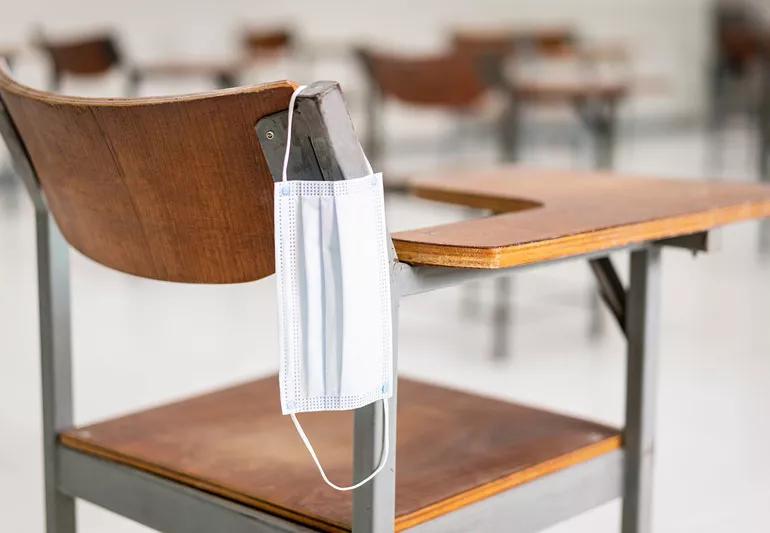Ending the U.S. public health emergency declaration doesn’t mean COVID-19 is gone

If you’ve been watching the news recently, you may have seen that May 11, 2023, was an important day. That’s the day United States President Joe Biden formally declared both the public health emergency and the national state of emergency for COVID-19 over.
Advertisement
Cleveland Clinic is a non-profit academic medical center. Advertising on our site helps support our mission. We do not endorse non-Cleveland Clinic products or services. Policy
Does that mean the pandemic is finally gone? Should we be celebrating?
Unfortunately, no: The COVID-19 pandemic isn’t going anywhere. What’s changing is the U.S. government’s approach, which means prevention, care and treatment are about to become more expensive in America.
We spoke to pulmonologist Raed Dweik, MD, about what ending the COVID-19 emergency declarations means for U.S. healthcare providers, insurance companies, the government and your day-to-day life.
To understand why the COVID-19 pandemic isn’t over, let’s do a quick refresher on the definitions of “epidemic,” “endemic” and “pandemic.”
Advertisement
As you might imagine, it’s hard to know when exactly a pandemic is over. It’s far easier to know if an epidemic has ended (or become endemic). Why? Because all the epidemiological data is concentrated in a single place.
In the case of a pandemic, you’re relying on each country to do two different things. First, they have to provide an adequate public health response to the crisis. Second, they have to gather and share accurate data about the impact.
So, when is a pandemic “over,” and who decides? Frankly, the answer to that question depends on who you’re asking. U.S. healthcare providers like Dr. Dweik often look to the World Health Organization (WHO) for determinations like that.
“Whether the pandemic is over or not is above my pay grade,” Dr. Dweik explains. “The WHO has to declare whether a pandemic is over because they take into account what’s happening and the number of cases in the rest of the world.”
Right about now, you might be thinking, “Didn’t the WHO say the pandemic was over, too?” Not exactly.
So, what does the WHO think about COVID-19? As of May 2023, the WHO still considers COVID-19 to be a pandemic. Yes, Director-General Tedros Adhanom Ghebreyesus did declare that COVID-19 is no longer “a public health emergency of international concern (PHEIC).” To use their definition, a PHEIC is: “An extraordinary event which is determined to constitute a public health risk to other States through the international spread of disease and to potentially require a coordinated international response.”
To qualify as a PHEIC, the WHO says a disease has to:
It’s great news that COVID-19 is no longer a PHEIC but, as that definition makes clear, there are plenty of serious medical concerns, including pandemics, that don’t rise to the level of a PHEIC.
In his statement ending the emergency phase of the COVID-19 outbreak, Ghebreyesus clarified that COVID-19 is still a global threat and warned that new variants could still emerge.
Here are a few reasons we can’t say the pandemic is over — and definitely can’t let our guard down.
According to the WHO’s COVID-19 tracker, the week of May 1, 2023, saw health authorities around the world report 595,281 cases of SARS-Co(v)2. The tracker stopped updating after the WHO suspended the PHEIC designation.
595,281 cases is a huge step down from the virus’ peak, when the number of people reported sick in a week was nearly 45 million. But it’s not a small number by any means — especially when you consider the global decline in reporting.
Take the United States as an example. After the state of emergency was suspended on May 11, 2023, the Centers for Disease Control and Prevention (CDC) stated that it would no longer report aggregate cases and deaths, along with several other important metrics for tracking a pandemic.
Advertisement
It’s sobering to think about: 6,927,378 people have died of COVID-19 since the start of the pandemic that we know about. The real number is far higher.
While the death rate has dropped significantly from its peak in January 2021 — when more than 102,000 people died in a single week — thousands of people still die of COVID-19 every week. At least, they did when the WHO was still reporting COVID-19 deaths.
From the beginning, the COVID-19 pandemic has looked dramatically different based on where you’re living and the information being made publicly available. Recently, China faced a major surge in COVID-19 cases — a side effect of lifting public health restrictions and poor-quality vaccines.
Why does that variation impact COVID-19’s pandemic classification? Simply put: If the virus is circulating, it’s also mutating. As we learned during the delta variant surge, some of those mutations can have devastating consequences.
The global risk remains high unless and until all countries are able to prevent, test and treat equally. The WHO is taking the current inequalities into account when they say the pandemic is still ongoing.
The COVID-19 crisis pushed healthcare systems and providers around the world to the brink. Despite valiant efforts to rise to the occasion, no country’s health infrastructure escaped unscathed.
Advertisement
While COVID-19 admissions are down in U.S. hospitals right now, the combination of COVID-19, respiratory syncytial virus (RSV) and the flu means most hospitals are still operating at (or over) max capacity. Healthcare providers have left the profession due to burnout. Many hospitals had to close their doors or were bought out. The same is true in healthcare systems around the globe.
The WHO has concerns about what will happen if COVID-19 deals the world another body blow. They’re concerned, in part, because countries aren’t collecting enough data for health officials to know exactly how stressed their pandemic-response infrastructure is.
Given the available information, it’s unlikely the WHO will declare the COVID-19 pandemic over any time soon. While they’re the ones who decide if a disease rises to the level of a pandemic, each nation has its own public health infrastructure and its own designations.
In the United States, President Joe Biden announced the end of both the national state of emergency and the public health emergency declarations on May 11, 2023.
It’s important to note that those emergency declarations are federal. Depending on where in the United States you live, there may still be state, municipal or county states of emergency in place. While local regulations made a big difference in the early months of the pandemic, the suspension of the federal declarations has a far greater impact on your day-to-day life at this stage.
Advertisement
“The federal emergency declarations back in 2020 affected all of us,” Dr. Dweik notes, “but we may have not known what they really meant.” He breaks down the changes we can expect to see in our daily lives, in healthcare and in government, in a post-emergency United States.
First things first: We need to re-emphasize that — for all that’s changed— one thing hasn’t: COVID-19 isn’t going anywhere. In the weeks before May 11, 2023, the CDC was still reporting more than 100,000 cases in the US every week, resulting in hospitalizations and deaths in the thousands. It’s probably safe to assume numbers are continuing to decline — especially as we move into the summer — but the virus isn’t in the rearview mirror by any means.
What’s changed isn’t the virus, but our country’s response to it. In other words, our experience of the virus will now look very different. Here are a few of the things you can expect now that May 11, is behind us.
The most immediate impact you can expect to see is on your wallet. “The cost of COVID testing, treatment and vaccines — all of that has been free at point-of-service because the federal government was paying for it,” Dr. Dweik reminds us.
Now, those costs are borne by insurance companies, Medicare, Medicaid … and you. How much you end up paying will vary based on the kind of coverage you have. If you don’t have any form of coverage, you’ll be paying 100% out of pocket for all COVID-19-related expenses.
In the United States, individual state healthcare budgets are not all the same. Dr. Dweik explains that during the state of emergency, the federal government put Medicaid coverage-matching protocols into place to make the financial strain easier for individual states to bear. Medicaid coverage-matching stopped when the national and public health emergency declarations expired. How big an impact that will have will vary from state to state.
“The big change for U.S. physicians and healthcare providers is going to be telehealth,” Dr. Dweik says.
For many of us, telehealth became a common feature of COVID-19-era medical care because the regulations governing the practice had to change to prevent the virus’ spread. According to Dr. Dweik, that will change — though, probably slowly— with the end of the state of emergency.
“Rules around telehealth were relaxed during the COVID pandemic, like who providers can see under what circumstances, whether you can see new patients or patients who are out of state, what platforms you can use for telehealth. That all got relaxed,” Dr. Dweik explains.
In the absence of a state of emergency, the rules governing telehealth before the pandemic will eventually go back into effect. Your healthcare provider may continue offering telehealth appointments, but only for some kinds of appointments — and with stricter rules about what your provider can and can’t do.
That’s particularly bad news for rural areas with limited access to hospitals and other healthcare services.
One of the reasons COVID-19 vaccines and treatments became available so quickly was because the U.S. Food and Drug Administration (FDA) granted manufacturers an Emergency Use Authorization (EAU). “Most people don’t realize that, if there’s no state of emergency, there’s no emergency use authorization for new treatments,” Dr. Dweik clarifies.
It’s important to keep in mind that the COVID-19 vaccines most commonly used in the U.S. (manufactured by Moderna and Pfizer, respectively) have already received full FDA approval.
One of the enduring images from the early days of the COVID-19 pandemic was planes full of doctors arriving in New York City — then, the epicenter of the pandemic — to tears and rapturous applause. They came from around the country and around the world to support the city in a moment of need.
The national and public health states of emergency made that humanitarian effort possible.
In normal circumstances, doctors and healthcare providers are licensed to practice medicine by state boards. That means they can only work within that state. Now, doctors aren’t able to do in-person or certain telemedicine appointments out of state.
The COVID-19 state of emergency also meant healthcare providers were less concerned about HIPAA liability than usual. HIPAA stands for the Health Insurance Portability and Accountability Act. It’s the law that governs patient privacy.
“If doctors do a visit over a phone, for example, that’s not HIPAA compliant,” Dr. Dweik explains. “Because patients could not come and see us during the COVID emergency, that kind of thing was allowed for a while. But it’s not OK under normal circumstances. Providers are supposed to use a secure platform to communicate with patients.”
Now that the state of emergency has ended, providers once again have to adhere to the letter of the law to protect themselves against legal action.
We may not all be familiar with the concept of “social determinants of health,” but COVID-19 made its meaning impossible to ignore.
Health outcomes vary from person to person. But at a macro level, health is often determined by our political, socioeconomic and cultural circumstances. That’s why the COVID-19 death rate was drastically higher for indigenous people, people of color, older people, immunocompromised or chronically ill people and people living with disabilities.
Ending the national and public health states of emergency impacts all of us, but underprivileged groups will once again fare worse.
“They’ll be the most affected again because members of underprivileged groups are the ones who are most likely to be uninsured or underinsured,” Dr. Dweik states. “The vaccines, the tests and the treatment are no longer going to be free at the point of service. If you are not insured, that’s a huge burden.”
He continues, “People who were already suffering before the pandemic will suffer again. In a way, the state of emergency helped mitigate some of the healthcare problems that we always had as a country. Lifting the state of emergency means we’ll go back to the situation before the pandemic, but with the added pressure caused by the remnants of the pandemic.”
One of the biggest question marks moving into a post-emergency era: Long COVID.
“It’s a conundrum for everybody,” Dr. Dweik says. “For the patients, for the healthcare providers — I suspect for insurance companies and the government, too. We don’t quite know what to do with long COVID. We have clinics for it, we’re researching it and we’re definitely trying to take care of people who have it, but it’s going be harder and harder as insurance coverage goes down.”
This is a problem that will only grow with time. “Long COVID is not only not going away, it’s increasing,” Dr. Dweik explains. “Some studies suggest one in every three to five patients with COVID could end up dealing with long COVID. And it can be debilitating for some people.”
The U.S. Department of Health and Human Services (HSS) and the U.S. Department of Justice (DOJ) issued formal guidance on long COVID as a disability covered by the Americans with Disabilities Act (ADA) in 2021. The guidelines say that some people living with long COVID may meet the definition of a disability under the law. That would entitle them to either workplace accommodations or — for those who can’t work — disability benefits.
But those guidelines are just that: guidelines. And applying for disability is a long process. Dr. Dweik is hopeful that continuing research on the condition, combined with political advocacy, will lead to stronger protections for people living with long haul COVID.
While the national and public health states of emergency are now a thing of the past, COVID-19 is still with us. As a pulmonologist, Dr. Dweik knows firsthand that protecting yourself against COVID-19 remains vitally important.
“The basic advice still applies,” he says. “Wash your hands. Get vaccinated. Wear a mask. Avoiding crowds is probably the most important thing. If you have to be involved in group activities, have them either outdoors or in large, well-ventilated spaces. And wear your mask.”
We don’t hear about masking as often now, but Dr. Dweik is quick to emphasize their importance. “One thing we learned from the pandemic, that I hope is not lost on us, is that, in the first year of the pandemic, we didn’t have any flu. The flu disappeared. That’s because we were wearing masks. It was a natural experiment that showed us masks work.” That’s why Dr. Dweik advocates for mask usage throughout the respiratory virus season and flu season, which, roughly, runs from October to March.
Preventive measures are important, but it’s equally important to respond to a positive COVID-19 test. “You need to keep on the lookout,” Dr. Dweik urges. “If you don’t feel well, make sure you tell your doctor early because there are treatments now that weren’t there at the beginning of the COVID pandemic. Those treatments can reduce the risk of hospitalization and the duration of the disease.”
On May 11, 2023, the Biden Administration announced the end of both the national and public health emergency declarations. While case numbers and death rates associated with the COVID-19 pandemic are declining, the pandemic isn’t over. Ending the emergency declarations simply means that the governmental response to the pandemic is scaling down.
You can expect to see costs associated with vaccination, testing and treatment go up. Rules around telemedicine, licensing, privacy and liability that were relaxed during the state of emergency will also go back to the way they were. The end of the state of emergency impacts everybody. But un- and underinsured people, communities with limited access to healthcare and people living with long COVID will feel the change the most.
That means protecting yourself against COVID-19 infection is as important as ever.
Learn more about our editorial process.
Advertisement

Covering your mouth when you cough and staying home when you’re sick are a couple ways to help keep yourself and others COVID-free

This vital nutrient supports your health, but its role in COVID-19 prevention and treatment isn’t proven

Studies have shown promising results, but additional research is needed

Infection and inflammation can cause you to lose your voice and have other voice changes until you’re fully healed

A COVID-19 infection can bring on depression or anxiety months after physical symptoms go away

Just like the flu, COVID-19 continues to evolve every year with new and smarter variants

The latest omicron subvariants carry specific mutations that may allow the SARS-CoV-2 virus to be better at evading immune protection

You can work out with mild COVID-19, but not in a gym, and listen to your body and don’t overdo it

If you’re feeling short of breath, sleep can be tough — propping yourself up or sleeping on your side may help

If you fear the unknown or find yourself needing reassurance often, you may identify with this attachment style

If you’re looking to boost your gut health, it’s better to get fiber from whole foods